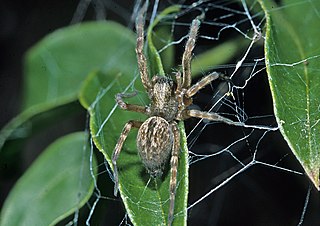
Uloboridae is a family of non-venomous spiders, known as cribellate orb weavers or hackled orb weavers. Their lack of venom glands is a secondarily evolved trait. Instead, they wrap their prey thoroughly in silk, cover it in regurgitated digestive enzymes, and then ingest the liquified body.

The Agelenidae are a large family of spiders in the suborder Araneomorphae. Well-known examples include the common "grass spiders" of the genus Agelenopsis. Nearly all Agelenidae are harmless to humans, but the bite of the hobo spider may be medically significant, and some evidence suggests it might cause necrotic lesions, but the matter remains subject to debate. The most widely accepted common name for members of the family is funnel weaver.

Titanoecidae is a family of araneomorph spiders first described by Pekka T. Lehtinen in 1967. It is fairly widespread in the New World and Eurasia with five genera and more than 50 species worldwide. These are mostly dark-colored builders of "woolly" (cribellate) silk webs. Several species are found at relatively high altitudes in mountain ranges and may be very common in such habitats.

Amaurobiidae is a family of three-clawed cribellate or ecribellate spiders found in crevices and hollows or under stones where they build retreats, and are often collected in pitfall traps. Unlidded burrows are sometimes quite obvious in crusty, loamy soil. They are difficult to distinguish from related spiders in other families, especially Agelenidae, Desidae and Amphinectidae. Their intra- and interfamilial relationships are contentious. According to the World Spider Catalog, 2023, the family Amaurobiidae includes 286 species in 50 genera.

Zoropsidae, also known as false wolf spiders for their physical similarity to wolf spiders, is a family of cribellate araneomorph spiders first described by Philipp Bertkau in 1882. They can be distinguished from wolf spiders by their two rows of eyes that are more equal in size than those of Lycosidae.

Dictynidae is a family of cribellate, hackled band-producing spiders first described by Octavius Pickard-Cambridge in 1871. Most build irregular webs on or near the ground, creating a tangle of silken fibers among several branches or stems of one plant.

Phyxelididae is a family of araneomorph spiders first described by Pekka T. Lehtinen in 1967 as a subfamily of Amaurobiidae, and later elevated to family status as a sister group of Titanoecidae.

Nigma is a genus of cribellate araneomorph spiders in the family Dictynidae, and was first described by Pekka T. Lehtinen in 1967. They have a wide distribution, including Eurasia, North America, and Northern Africa. N. walckenaeri is one of the biggest members of the Dictynidae, growing up to 5 millimetres (0.20 in) long. They are translucent green and sometimes have red or black markings on the abdomen.

Badumna is a genus of intertidal spiders that was first described by Tamerlan Thorell in 1890. They are harmless spiders that can be found around human structures and buildings. The most well-known species is B. insignis, also known as the "black house spider" or "black window spider".

Stiphidion is a genus of South Pacific sheetweb spiders that was first described by Eugène Louis Simon in 1902. Originally placed with the Psechridae, it was moved to the Stiphidiinae in 1967. It is considered a senior synonym of Amarara.

Alistra is a genus of dwarf sheet spiders that was first described by Tamerlan Thorell in 1894.

Hahnia is a genus of dwarf sheet spiders that was first described by C. L. Koch in 1841.
Benoitia is a genus of funnel weavers first described by Pekka T. Lehtinen in 1967.
Tamgrinia is a genus of Asian funnel weavers first described by Pekka T. Lehtinen in 1967.
Forsterina is a genus of South Pacific intertidal spiders that was first described by Pekka T. Lehtinen in 1967.
Callevophthalmus is a genus of Australian cribellate araneomorph spiders in the family Dictynidae, and was first described by Eugène Simon in 1906. As of May 2019 it contains only two species: C. albus and C. maculatus. Originally placed in the Amaurobiidae, it was moved to the Dictynidae in 1967.

Lathys is a genus of cribellate araneomorph spiders in the family Dictynidae, and was first described by Eugène Simon in 1884. It is a replacement name for "Lethia" Menge, 1869 because that name was already in use as a synonym for a genus of moths.
Baiami is a genus of Australian intertidal spiders that was first described by Pekka T. Lehtinen in 1967. Originally placed with the Stiphidiidae, it was transferred to the Desidae after the results of a 2019 genetic analysis.
Taira is a genus of East Asian tangled nest spiders first described by Pekka T. Lehtinen in 1967.












